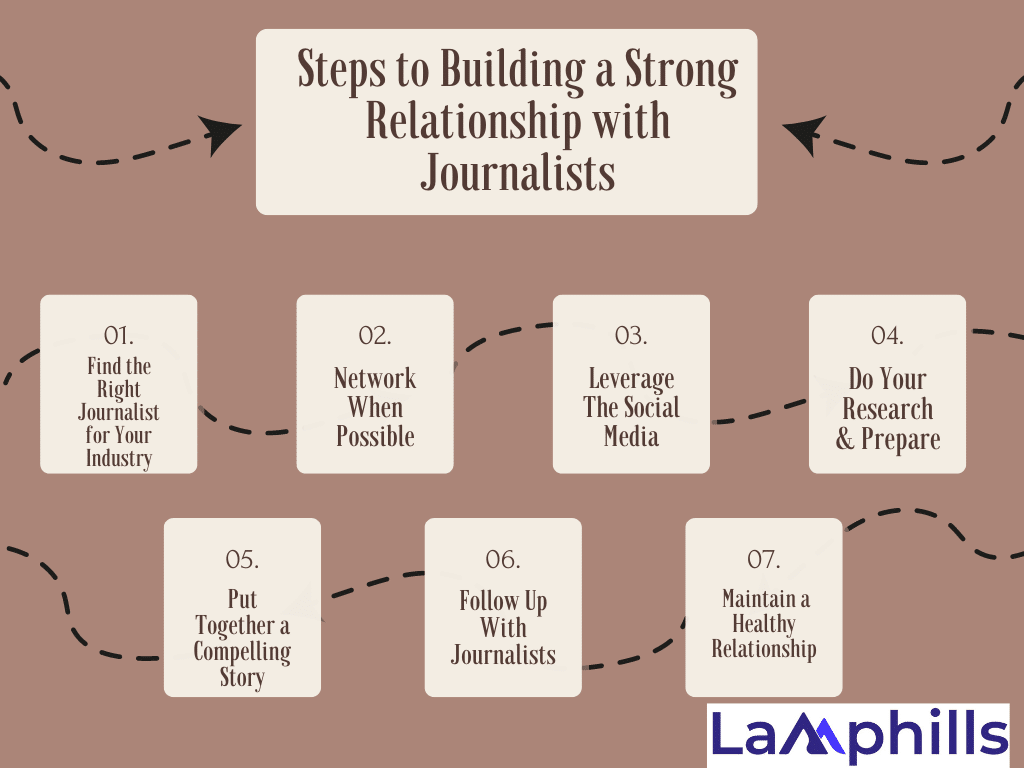Your organization has a wonderful story; perhaps you recently introduced a game-changing product or took home a significant award. You send a press release to every journalist you can think of because, of course, you want the world to know. After that, you have to wait. Can you relate to this? I have also been there. It’s annoying, but it serves as a stark reminder of how important it is in today’s business environment to cultivate solid connections with journalists.
This is because effective media relations require more than simply having a compelling story to tell; it also requires building a strong relationship with the right journalists. To that effect, In this article, I’ll discuss tactics for understanding journalists’ requirements, establishing trust and credibility, communicating effectively, staying consistent, forging personal connections, and offering value, while soliciting feedback.
Key Takeaways
- Sending generic press releases to every journalist will be ineffective. Instead, it’s essential to thoroughly research and understand each journalist’s interests and coverage areas.
- Building relationships through phone and email is possible, in-person meetings at industry events, conferences, or informal meetups like coffee chats creates stronger, more lasting bonds.
- Your stories should be concise and compelling, with a strong, attention-grabbing subject line. Highlighting the uniqueness and relevance of the story to the journalist’s interests is critical. The pitch should quickly convey why the story matters and why the journalist should cover it.
- Following up on pitches shows respect for the journalist’s time and interest. Quick and thoughtful follow-ups, providing additional information when needed, and maintaining regular contact even when there’s no immediate news to share help build trust and long-term relationships.
Who A journalist Is and Why You Need One

A journalist is a person who gathers information in the form of text, audio, or pictures, processes it into a newsworthy form, and disseminates it to the public. In today’s ever-changing digital media world, developing relationships with journalists is more vital than ever.
This is because journalists are continuously overwhelmed with pitches, press releases, and requests for coverage, making it difficult for a single message to stand out. However, with a good relationship in place, your message is more likely to be heard and receive the attention it deserves.
The truth is that journalists are trendsetters, pushing many of the trends and patterns we see on social media and in everyday life. They decide what goes in and what goes out, as well as what new content will be presented in their newspapers and online channels. Building true relationships with them is critical to your success in media.
Therefore, as with any successful relationship, developing one with a journalist necessitates open communication, trust, and sincerity. But most significantly, it necessitates effort and care. Building ties with journalists can help you position your business as a thought leader in your sector.
I learned that building relationships with journalists isn’t just about sending a press release and hoping for the best. It’s about genuine connections, trust, and mutual respect. Today, I want to share with you some of the lessons I’ve learned along the way about mastering media relations.
My Tested And Proven Steps to Building a Strong Relationship with Journalists

Building a strong relationship with journalists is one of the most effective strategies to secure publicity for your organization or latest project. This is why it’s important that before contacting news media or publications with a story, you must first create contacts with journalists, such as:
#1. Find the Right Journalist for Your Industry
One of the most significant turning points in my PR career was realizing how crucial it is to comprehend the needs of journalists. I sent boilerplate proposals to every journalist on my list early on, which was a mistake. It should come as no surprise that this strategy was unsuccessful.
This makes me aware of why businesses that are new to media relations are frequently taken aback when they discover that it frequently takes a lot longer to locate the appropriate journalists for their stories than it does to get in touch with them. However, one of the most significant advantages of hiring a public relations firm is that it provides businesses with a whole team of media experts whose sole responsibility is to research the media environment and locate the best journalists for their customers.
So, go ahead and take developing connections with journalists off the table if you are not willing to put in a large amount of upfront study into your company’s areas of interest, the media sources that publish content in those areas, and the journalists that write for those publications.
In the same way that most individuals aren’t interested in getting hundreds of cold calls a day from someone selling a product or service that has no relevance to them, journalists aren’t interested in hearing about news or topics that aren’t in their coverage area.
For those who aren’t in this position, start by identifying the periodicals that are read not only by your organization and its executives but also by decision-makers in the companies or markets you wish to target. From there, begin compiling a list of journalists who write for those magazines and have published stories relating to the news or story that you intend to offer them.
#2. Network When Possible
Building relationships with journalists via phone and email is possible, but face-to-face encounters will always be more effective. Journalists can get a deeper idea of spokesmen and executives’ personalities and conduct conversations that would not happen in a Zoom meeting, especially if they can meet in person over coffee or at an event. To help you, here are some of my favorite ways to network with journalists—even in remote-first workplaces.
a. Attend Industry Events, Tradeshows, and Conferences
Events and tradeshows can be overwhelming because there are so many competitors vying for the same journalists’ attention as your brand. Journalists’ availability at these events is restricted, so corporations must reserve time on their calendars in advance. Reach out to media attendees a few weeks before the show to communicate any news and arrange in-person meetings with corporate leaders. These events typically have a media list that is shared with participants and sponsors ahead of time. If journalists’ time slots are already taken, suggest a follow-up chat after the event.
B. Join Journalist-specific Networking Groups
Journalists are frequently willing to collaborate directly with public relations experts and companies to help flesh out the stories they are already planning. One way to accomplish this is through journalist-specific networking groups, where journalists can post about the content they want to create and where they may require an additional opinion or two to flesh out the article. This is a fantastic chance for businesses to go straight to the source and provide professional insights on areas that journalists are already interested in.
C. Take Advantage of In-Person Travel
Meeting journalists in person can create a lasting impression. I recall going to a tech conference and finally meeting a journalist I had been contacting for months. That face-to-face meeting strengthened our bond, making subsequent communications much more productive and pleasant.
Is your company based in a major city such as New York City, Los Angeles, or San Francisco? Even if they don’t, many business executives must go to these places for work and can use the opportunity to network with journalists. Research which journalists are based in these cities, then sift through the ones that are relevant to your firm and have your public relations staff (or the executive themself) reach out to offer a brief meet-and-greet over coffee or at an office.
Also, inviting local journalists to any events your company is hosting that are relevant to the media (and won’t divulge any information or work you aren’t yet ready to share) is another good strategy. The key here, as with any media strategy, is knowing who you are reaching out to and that they’re in proximity to you.
#3. Utilize The Social Media
Social networking is an excellent way to create relationships. I frequently comment on journalists’ pieces or share their work, providing critical thoughts. This engagement demonstrates that I value their work beyond my immediate demands. It’s a simple but efficient method to stay connected.
This means social networking is an effective tool for establishing and sustaining relationships with journalists, as well as increasing the visibility of your content. One useful method is to follow journalists on social media and interact with their posts. This can involve sharing their articles, responding to their postings, and thanking them for their coverage. It is also critical to consistently post your material on social media and personalize it to the platform and audience. For example, Twitter is ideal for short and timely updates, while LinkedIn is better suited for longer, more professional content.
Another effective method is to utilize hashtags to boost the visibility of your content and engage in related conversations. This can help you establish yourself as a thought leader in your sector and capture the attention of journalists covering your beat. Social media can also be used to find and connect with journalists interested in your topic or sector. Tools like Twitter lists, LinkedIn groups, and Facebook communities can assist you in discovering and engaging with journalists who are relevant to your business.
#4. Do Your Research & Prepare
Start by reading their work. What are the themes they cover? What are their preferred angles? I once spent a week immersed in the work of a journalist that I admired. When I finally gave her a pitch, it was personalized to her interests and style. She responded within a day, and we’ve had a fantastic working relationship since.
I began reading the work of journalists with whom I hoped to relate. This entailed looking over their previous pieces, analyzing their beats, and recognizing their writing style. For example, I once submitted a digital innovation article to a writer who primarily covered environmental issues—no surprise I didn’t hear back! By tailoring my pitches to their interests, I witnessed a huge rise in response rates. Even once a comprehensive list of journalists has been compiled and it is time to begin reaching out, further research is required.
In addition, putting this extra degree of consideration into every engagement with journalists is frequently what leads to developing long-term, meaningful connections that firms can revisit time and again. In essence, it is critical to maintain consistent communication even when there is no immediate story to tell.
#5. Put Together a Compelling Story
A personal pitch demonstrates that you value the journalist’s work and time. For example, I once presented an article about an innovative environmental project to a journalist known for her environmental advocacy. I mentioned how the project related to her prior tales, and she not only covered it but also requested follow-up pieces.
In essence, narrative is at the heart of journalists’ work and should be at the heart of all interactions with journalists. Instead of promoting your company based on features and functionalities that other companies may be focusing on, pique people’s interest by painting a picture of the possibility for a broader audience.
To create an engaging story, ask yourself these questions. What value does your product provide to users? How will it make our lives easier or better? How does it relate to the conversations in which your audience is now engaged? When communicating in this manner, even the most simple corporate news can be converted into a much greater story. So,
a. Tailor Your Pitch to Match Journalist’s Interests
Journalists are often highly busy people, so keep your pitches short and to the point. A reporter will know within the first few phrases of your pitch if it is something they want to cover, so reserve the details for a follow-up email or phone contact once the journalist has expressed interest in your topic.
To achieve this, keep in mind that journalists do not spend all day reading emails. Respect their time and deadlines by keeping pitches succinct and getting directly to the point. If the lede is buried, the journalist is unlikely to read to the end to discover it.
B. Highlight the Relevance and Uniqueness of Your Story
Pitches are not requests that journalists cover your story. They’re a means to provide journalists with useful facts and insights, demonstrating why your firm is uniquely positioned to tell a story no one else can. Use the research you conducted to determine what is relevant to the journalist you are pitching to make your media pitch a direct reflection of why the journalist should care about your story.
#c. Create an Attention-Grabbing Subject Line
Imagine the sensation of sorting through your email inbox on a Monday morning, and how you decide what you’re going to read and what you’re going to trash immediately. Most likely, you made that judgment in an instant based on the email’s subject line. Now that’s exactlywhat journalists face daily.
The subject line of an email provides around 5-7 words to express your tale before being cut off by the email preview window on a computer or phone screen. This is the first thing journalists will see before determining whether or not to open your pitch, let alone read it.
As a result, your pitch subject lines should provide a clear, short, and compelling overview of the story that will be told throughout the pitch. Are you inviting a major company’s CEO to an interview? Providing an inside peek at a new product. Announcing a financing round or an exit strategy? Are you offering new research? Communicate it quickly in the topic line.
#6. Follow Up With Journalists
Following up quickly demonstrates that you appreciate the journalist’s time and interest. I once responded within an hour to a journalist’s request for additional information. That speedy turnaround allowed them to reach their deadline, and they’ve been open to my suggestions ever since. This means that even after you’ve sent out pitches, your work is not finished. Just as crucial as mastering the art of developing a media pitch is mastering the art of follow-through.
A decent rule of conduct is to wait at least three business days, if not a week, before following up on an unanswered pitch. Again, bear in mind that journalists have a limited amount of time to react to emails, so follow-ups should be brief and focused.
If your narrative has progressed since your last conversation, the follow-up is an excellent opportunity to share it. Otherwise, keep your message brief, briefly reaffirming what you’re offering the writer, and then wrap it up. Keep in mind that if your original media pitch fits the parameters outlined above, the requirement for a follow-up will become less often.
#7. Maintain a Healthy Relationship
It is critical to maintain ties that go beyond the immediate story. I keep in touch with journalists by providing industry news or simply checking in. This keeps the relationship going, even when there is no immediate story to pitch.
Maintaining good ties with journalists, like any other relationship, requires care. So, treat journalists as you would any valued and respected colleague, such as following up with them after an interview to thank them for their time and close the loop on any lingering items they may have requested.
Another strategy to keep in touch with journalists is to provide upcoming, important announcements from your company before they happen. Journalists require time to prepare a story before it can be published, so giving them plenty of notice and adhering to their deadlines will help you maintain strong connections.
In addition to this simple gestures, such as thank you cards or holiday wishes, can go a long way. I make it a point to recognize journalists’ hard work, which strengthens our friendship and demonstrates that I appreciate the relationship beyond transactional encounters.
You can also make reference to the checklist below,
What are some common mistakes to avoid in media relationship management?
Mistakes in media relationship management frequently occur when information is not correct, when responses are slow or untrustworthy, when interviews are ill-prepared when trust is not established, and when rapport-building is not prioritized. Additionally, it’s critical to refrain from using excessive aggression or manipulation when dealing with journalists.
How can I prepare for media interviews?
To prepare for media interviews, conduct research on the journalist and their outlet, create key messaging and talking points, anticipate likely questions and practice responses, and prepare supporting resources such as data or visuals. It is also critical to dress professionally and convey confidence and calmness throughout the interview.
How can social media be used to enhance media relationship management?
Social media can be used to improve media connections by interacting with journalists on their platforms and sharing relevant content. It can also be used to track and respond to media coverage, as well as to communicate news and updates in real-time. Social networking might also help you connect with fresh journalists.
Conclusion
Building successful and a strong relationship with journalists is an ongoing process of understanding, communication, trust, and consistency. By focusing on genuine connections and offering value, following the steps in this article, you can build long-term, mutually beneficial collaborations. Begin now—research, reach out, and cultivate these relationships that leads to significant media coverage and long-lasting professional partnerships.
References
- cision.com
- entrepreneur.com
- channelvmedia.com
- agilitypr.com






